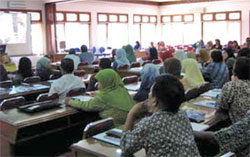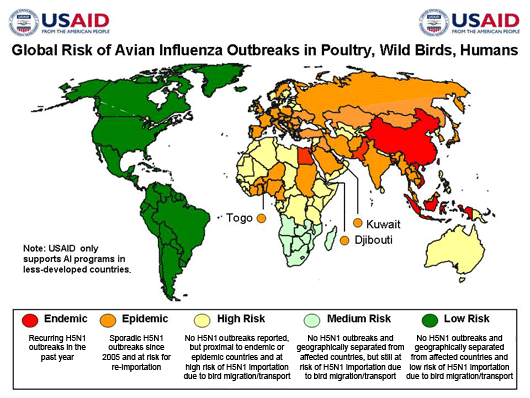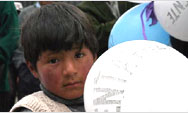Avian Influenza Response
| |
 |
|
|
|
 |
| |
Muhammadiyah, a grassroots Islamic organization in Indonesia, is working with teachers and students and is also helping “backyard” farmers to improve safe poultry practices in order to reduce the AI threat.
Read more... [PDF, 78KB] |
|
|
|
|
|
|
Since its emergence in Southeast Asia in 2003, avian influenza has swept across Asia, Europe and Eurasia, and Africa. Between February and April 2006, the number of countries reporting H5N1 in animals was more than double the number of countries reporting cases between 2003 and 2005. Because of the rapid spread of the virus, there is growing concern it could develop into a global human pandemic with the potential to kill millions.
Over 220 million birds have died from the disease, either through infection or culling efforts to contain and prevent further spread of H5N1. This threatens the livelihoods of poultry farmers, economic growth, and overall sustainable development — the World Bank estimates a severe pandemic could cost up to $2 trillion globally. As of September 10, 2008, at least 387 human cases of H5N1 have been confirmed, with 245 fatalities, in 15 countries in Europe, Asia, and Africa. Given the rapid spread of the H5N1 virus and the impact on the international community, the United States is actively engaged in international efforts to contain and lessen the impact of the virus.
The U.S. Agency for International Development (USAID) and its U.S. government partners, including U.S. Departments of State, Health and Human Services (HHS), and Agriculture (USDA), are working to coordinate international preparedness and response measures on behalf of the White House. The United States also collaborates closely with international organizations, including the World Health Organization (WHO), the United Nations Food and Agriculture Organization (FAO), the World Organization for Animal Health (OIE), and 88 foreign governments, on global preparedness with particular focus on:
- Enhancing avian and pandemic influenza planning and preparedness on national levels, including facilitating the development of national plans
- Monitoring flyways of migratory birds that can carry the virus
- Strengthening outbreak surveillance, response, and containment
- Encouraging transparency in reporting and investigating avian influenza occurrences.
Global Risk of Avian Influenza Outbreaks

|
| Map last updated: September 1, 2008 |
Source: Andrew Clements/USAID |
U.S. Government Actions
To enhance global pandemic preparedness, President Bush announced the International Partnership on Avian and Pandemic Influenza (IPAPI) in his remarks to the High-Level Plenary Meeting of the United Nations General Assembly on September 14, 2005. As of December 2007, the U.S. Government's total commitment to fighting avian and pandemic influenza is $629 million, with an overall USAID commitment of $352 million for these efforts globally.
Through the IPAPI, nations and international organizations collaborate to improve international readiness in key areas through actions that include:
- Elevating the issue on national agendas
- Coordinating efforts among donor and affected nations
- Mobilizing and leveraging resources
- Increasing transparency in disease reporting and surveillance
- Building capacity to identify, contain, and respond to a pandemic influenza
All partners have endorsed a core set of principles focused on enhancing preparedness, prevention, response, and containment activities. The Partnership will build on and support ongoing domestic, bilateral, and multilateral avian and pandemic influenza programs. To view the core principles, visit the State Department website.
Latest News and Resources on the USAID Response
- Record-Level U.S. Support for Bird Flu Programme - 11/12/08
- U.S. International Avian and Pandemic Influenza Assistance Approaches $950 Million - 10/25/08
- USAID Continues to Bolster Sri Lanka’s Defense Against Avian Influenza - 10/09/08
- USAID, Agriculture and Health Professionals of the Central Asian Countries Discuss Potential Highly Pathogenic Avian Influenza (HPAI) Pandemic Preparedness - 09/30/08 [PDF, 34KB]
- USAID Has Launched Its Stamp Out Pandemic and Avian Influenza (STOP AI) Project in Central Asia - 09/17/08 [PDF, 31KB]
- Campaign Keeps Avian Flu at Bay - 07/03/08
- U.S. Enhances Azerbaijan’s Preparedness and Capacity to Face Outbreaks of Avian Influenza - 07/01/08
- USAID Supports Sri Lanka’s Efforts Against AI - 06/25/08
- Regional Experts and Governments Cooperating to Battle Avian Influenza Outbreaks - 06/09/08 [PDF, 36KB]
- USAID Launches Region's First Avian Influenza Regional Distribution Center in Thailand - 03/18/08
- USAID Mourns the Loss of Steve Wilbur, Director of USAID | DELIVER Project's Avian Influenza Task Order - 02/25/08
- U.S. Provides Additional Funding for Avian Flu Fight in India - 02/21/08
- USAID Donates More Equipment to Help Fight Spread of Avian Influenza in Pakistan - 01/23/08
- "Substantial Progress" in Global Avian Flu Response, Report Says - 12/04/07
- Nations Examine Pandemic Flu Preparedness at India Conference - 12/03/07
- U.S. Government Provides an Additional $10.5 million to Vietnam for Avian and Pandemic Influenza Prevention and Control - 11/07/07
- USAID Continues to Strengthen Avian Influenza Surveillance and Response in Turkmenistan - 09/18/07 [PDF, 48KB]
- Food and Agriculture Organization (FAO) Develops Community-Level Avian Influenza Surveillance in Indonesia with USAID Support - 07/26/07
- The U.S. Government, through USAID, to Provide up to $24 Million in AI Support to Egypt Over the Next Three Years - 07/01/07
- Report: U.S. Leads Avian Influenza Efforts - 06/21/07
- Fact Sheet: USAID: Investing in People - 05/31/07
- USAID Donates Avian Influenza Protective Gear To Pakistan - 05/01/07
- USAID Bolsters International Avian Influenza Response - 03/30/07
- USAID to Strengthen Delivery of Avian Influenza Commodities Globally - 03/30/07
- U.S. Officials Offer Pandemic Flu Aid in Egypt, Switzerland - 02/23/07
- U.S. Ambassador to Indonesia Presents Protective Gear to Aid in the Battle against Avian Influenza - 01/26/07
- United States Announces Additional Donation to Food and Agriculture Organization (FAO) Emergency Programs - 10/11/06
- Statement on Avian Influenza from Randall L. Tobias, Director of U.S. Foreign Assistance and USAID Administrator - 09/21/06
- The U.S. Provides an Additional $3.2 million to Indonesia for Avian Influenza Prevention - 09/15/06
- Fact Sheet: USAID Advances U.S. International Engagement on Avian Flu - 06/16/06
- USAID Announces $5 Million Award to Enhance International Efforts to Track Avian Influenza - 06/09/06
The Global Avian Influenza Network for Surveillance (GAINS) will enhance international efforts to collect and analyze laboratory samples from wild birds and identify genetic changes in the virus.
Related USAID Programs
Additional Information on Avian Influenza (Bird Flu)
|


